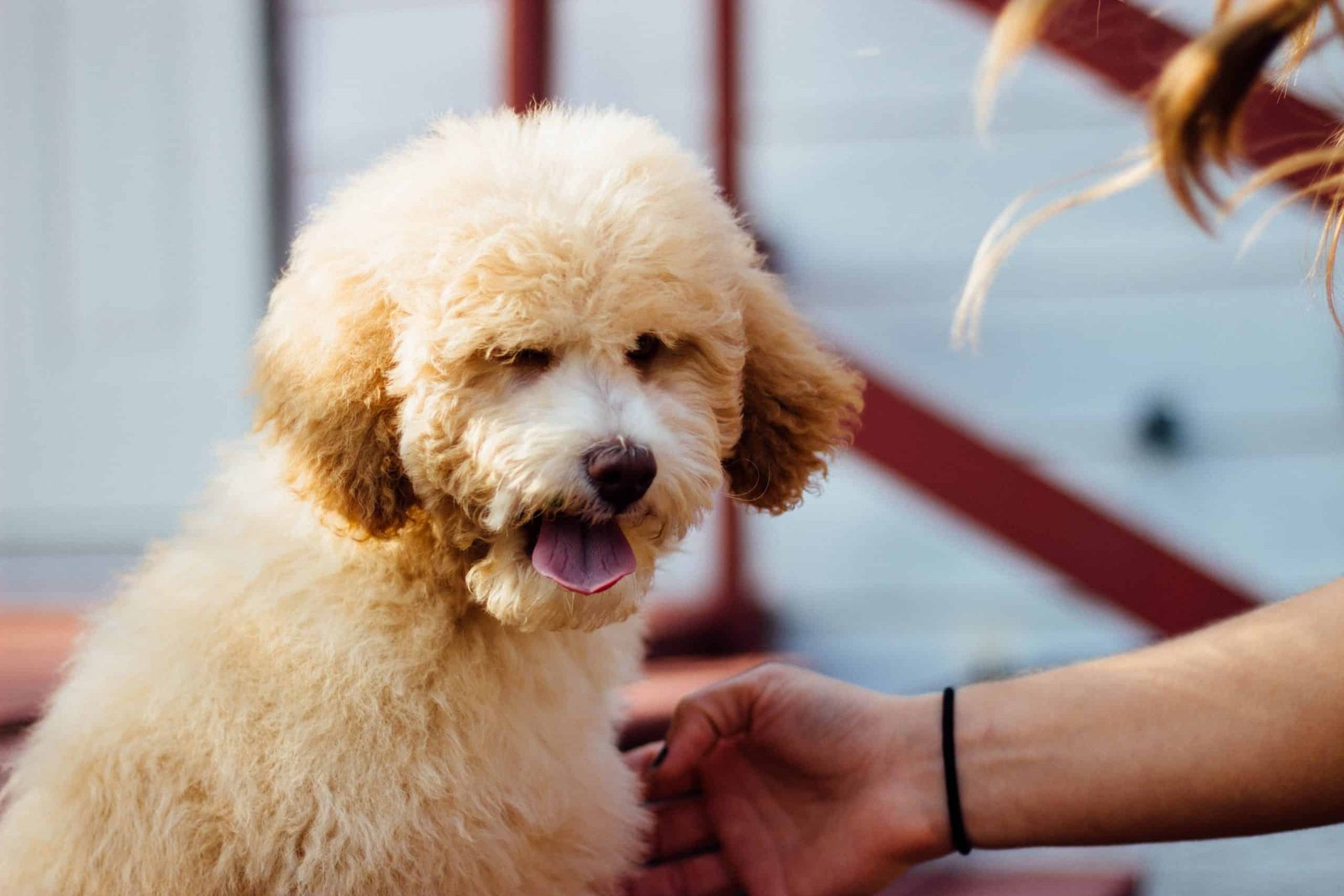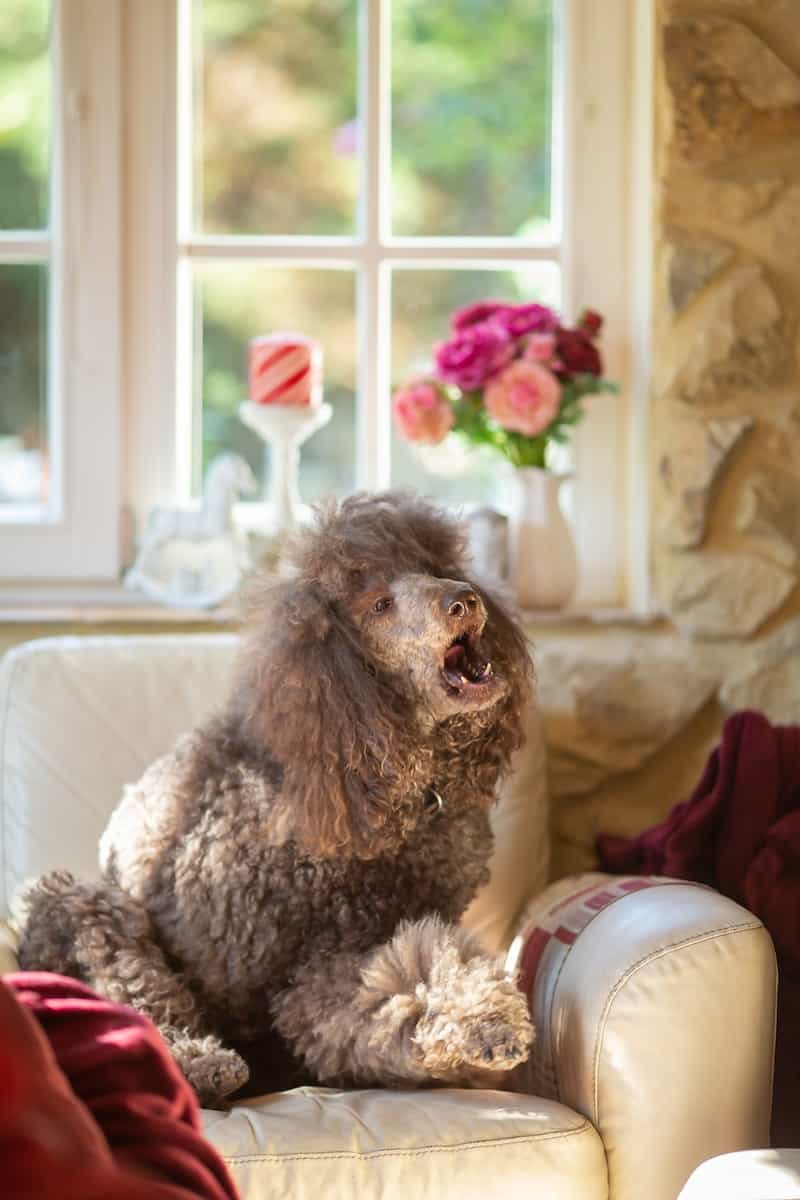
As a poodle owner, you know that your furry friend is a loyal companion who brings joy to your life. However, sometimes you may notice that your poodle acts out when you leave them alone. This behavior could be a sign of separation anxiety, a common issue among poodles. Separation anxiety can be distressing for both you and your pet, but recognizing the signs and taking appropriate action can help manage the condition.
Understanding the signs of separation anxiety in your poodle is the first step to addressing the issue. Common signs of separation anxiety in poodles include excessive barking, whining, howling, and destructive behavior such as chewing furniture or digging holes in the yard. Your poodle may also become agitated or restless when they sense that you are about to leave. Recognizing these signs can help you take action to manage your poodle’s separation anxiety and alleviate their distress.
Key Takeaways
- Recognizing the signs of separation anxiety in your poodle is the first step to addressing the issue.
- Common signs of separation anxiety in poodles include excessive barking, whining, howling, and destructive behavior.
- Taking appropriate action to manage your poodle’s separation anxiety can help alleviate their distress.
Understanding Distress from Isolation
As a poodle owner, it’s important to understand distress from isolation and how it can affect your furry friend. Distress from isolation is a common condition that affects many dogs, including poodles. It occurs when a dog becomes overly attached to their owner and experiences unease when left alone.
Anxiety is a natural response to stress, but when it becomes excessive, it can lead to negative consequences for your dog’s health and well-being. Distress from isolation in poodles can lead to destructive behavior, excessive barking or whining, and even physical symptoms such as vomiting or diarrhea.
Common symptoms of anxiety in dogs include shaking, trembling, panting, and pacing. If you notice any of these symptoms in your poodle when you’re about to leave or after you’ve left, they may be experiencing distress from isolation.
It’s important to note that distress from isolation is not limited to puppies – dogs of all ages can develop this condition. If you suspect that your poodle is experiencing distress from isolation, it’s important to seek help from a veterinarian or animal behaviorist.
By recognizing the signs of distress from isolation and taking the necessary steps to manage it, you can help your poodle feel more comfortable and secure when you’re not around. In the following sections, we will discuss the signs of distress from isolation in more detail and provide tips for helping your poodle cope with this condition.
Recognizing Signs of Distress from Isolation
Distress from isolation is a common behavioral problem in dogs, including poodles. It occurs when a dog experiences excessive fear or stress when left alone or separated from their owner. If your poodle is suffering from distress from isolation, it can lead to destructive behavior and other negative consequences. It is important to recognize the signs of distress from isolation in your poodle so that you can take the necessary steps to help them feel more comfortable and secure when you are not around.
Physical Symptoms
One of the most common signs of distress from isolation in poodles is physical symptoms. These symptoms can include excessive barking, pacing, howling, chewing, whining, panting, excessive salivation, escape attempts, digging, destruction, crying, destructive chewing, urinating, defecating, coprophagia, licking, pacing, and restlessness. If your poodle exhibits any of these behaviors when you are not around, it may be a sign that they are experiencing distress from isolation.
Behavioral Symptoms
In addition to physical symptoms, distress from isolation can also cause behavioral symptoms in poodles. These symptoms can include excessive barking, destructive behavior, and signs of isolation distress. When a poodle is suffering from distress from isolation, they may become destructive and chew on furniture, shoes, or other household items. They may also bark excessively or howl when left alone. Isolation distress is another common behavioral symptom of distress from isolation in poodles. Your poodle may become anxious and stressed when you leave the house, and they may follow you around the house or become clingy.
Recognizing the signs of distress from isolation in your poodle is the first step to helping them feel more comfortable and secure when you are not around. If you suspect that your poodle is suffering from distress from isolation, it is important to seek the help of a professional dog trainer or behaviorist. They can help you develop a training plan to help your poodle overcome their distress from isolation and feel more comfortable and secure when you are not around.
Causes of Distress from Being Alone
Distress when separated in dogs, including poodles, is a common issue that can arise during puppyhood or later in life. It is a behavioral disorder that can result in destructive behavior and excessive barking when a dog is left alone.
The causes of isolation distress are not fully understood, but several factors can contribute to its development. One of the primary causes is a lack of socialization during puppyhood. Poodles that do not receive adequate exposure to different people, animals, and environments may develop anxiety when separated from their owners.
Life changes can also trigger loneliness-induced distress in poodles. Moving to a new home, the loss of a family member or a pet, or a change in the owner’s work schedule can all cause stress and anxiety in dogs. Additionally, poodles that are used to constant companionship may struggle when left alone for extended periods.
Another potential cause of being alone discomfort in poodles is a lack of companionship. Dogs are social animals and thrive on interaction with people and other dogs. Poodles that spend too much time alone may become anxious and develop destructive behaviors.
In summary, anxiety from isolation can be caused by a variety of factors, including lack of socialization, life changes, and lack of companionship. It is essential to address the underlying causes of solitude-related distress to help your poodle overcome this issue.
Training Your Poodle to Manage Distress from Being Alone
Feelings of loneliness is a common issue that many poodle owners face. If your poodle shows signs of separation-related discomfort, it is important to address the issue as soon as possible. Training your poodle to manage loneliness-induced distress requires patience, time, and effort. In this section, we will discuss some effective training techniques that can help your poodle overcome anxiety from isolation.
Socialization
Socialization is an essential part of training your poodle to manage distress when separated. Proper socialization helps your poodle become comfortable with new people, places, and experiences. This can help prevent isolation discomfort triggers from developing in the first place. Introduce your poodle to new people, places, and experiences in a positive and controlled manner. This can help build your poodle’s confidence and reduce anxiety.
Desensitization
Desensitization is another effective training technique for managing isolation distress. The goal of desensitization is to gradually expose your poodle to separation triggers in a controlled and positive manner. This can help your poodle become more comfortable with being alone and reduce anxiety. Start with short periods of separation and gradually increase the time. Use positive reinforcement, such as treats or praise, to reward your poodle for calm behavior.
Crate Training
Crate training can be an effective tool for managing anxiety from isolation. A crate provides a safe and secure space for your poodle to relax and feel comfortable. Start by introducing your poodle to the crate in a positive and controlled manner. Use treats or toys to encourage your poodle to enter the crate. Gradually increase the amount of time your poodle spends in the crate, using positive reinforcement to reward calm behavior. It is important to make sure your poodle has access to water and toys while in the crate.
Training your poodle to manage distress from being alone requires patience, time, and effort. It is important to be consistent and use positive reinforcement to reward calm behavior. With proper training and socialization, you can help your poodle overcome separation-related discomfort and feel comfortable being alone.
Professional Help and Treatment Options
If you suspect that your poodle is suffering from distress when separated, it is essential to seek professional help. A veterinarian or animal behaviorist can diagnose the condition and recommend the appropriate treatment plan.
Professional Help
Your veterinarian can rule out any underlying medical conditions that may be contributing to your poodle’s behavior. An animal behaviorist can help you identify the root cause of your dog’s loneliness-induced distress and develop a tailored treatment plan.
Treatment Options
There are several treatment options available for distress from being alone in dogs. The most common treatment is behavior modification, which involves gradually exposing your poodle to the triggers that cause anxiety and teaching them coping mechanisms.
Cognitive-behavioral therapy (CBT) is another effective form of psychotherapy for anxiety from isolation in dogs. This type of therapy helps your dog learn new coping skills and behaviors to manage their anxiety.
In some cases, medication may be prescribed to help your poodle cope with their anxiety. Anti-anxiety medications can be effective in reducing symptoms of separation-related discomfort, but they should only be used under the guidance of a veterinarian.
Relief and Treatment
It is important to note that distress from being alone in dogs can be a long-term condition that requires ongoing management. With the right treatment plan, however, most dogs with isolation distress can experience significant relief and lead happy, healthy lives.
If you suspect that your poodle is suffering from loneliness-induced distress, seek professional help as soon as possible. With the right treatment plan, you can help your dog manage their anxiety and enjoy a happy, healthy life.
Preventing Distress from Being Alone
As a poodle owner, preventing distress when separated in your furry friend is crucial for their well-being and your peace of mind. Feelings of loneliness is a common behavioral issue that can lead to destructive behavior, excessive barking, and other undesirable habits. Here are some tips to help prevent anxiety from isolation in your poodle.
Establish a Routine
Dogs thrive on routine, and having a consistent schedule can help alleviate anxiety. Try to establish a routine for feeding, exercise, and playtime. Stick to a regular schedule for leaving and returning home, so your poodle knows what to expect and when.
Provide Plenty of Exercise and Stimulation
Regular exercise and mental stimulation can help your poodle expend energy and reduce anxiety. Take your poodle for daily walks, play fetch, or engage in other activities that your poodle enjoys. Consider puzzle toys or treat-dispensing toys to keep your poodle entertained while you’re away.
Encourage Independence
Teach your poodle to be comfortable spending time alone. Start by leaving your poodle alone for short periods and gradually increasing the time. Encourage your poodle to spend time in a designated area, such as a crate or bed, while you’re away.
Use High-Value Treats
Offering high-value treats, such as a stuffed Kong toy, can help distract your poodle and make them feel more comfortable while you’re away. Reserve special treats for when you leave, so your poodle associates your departure with something positive.
Maintain Consistency
Consistency is key when it comes to preventing separation-related discomfort. Avoid making sudden changes to your routine or environment, as this can cause stress for your poodle. If you need to make changes, do so gradually and with plenty of positive reinforcement.
By following these tips, you can help prevent loneliness-induced distress in your poodle and ensure that they feel comfortable and secure while you’re away. Remember to be patient and consistent, and seek the help of a professional trainer or behaviorist if needed.
Monitoring Signs of Distress
It’s crucial to observe your poodle closely for signs that they might be feeling distress from being alone. Changes in behavior, such as excessive chewing, digging, barking, or even depression, can be indications of loneliness-induced distress. The sooner you recognize these signs, the quicker you can implement strategies to help your poodle adjust and feel more comfortable.
Positive Reinforcement
Always reward your poodle for good behavior. Positive reinforcement not only strengthens the bond between you and your dog but also promotes confidence in them. Whenever they show signs of dealing well with being alone, give them praise, treats, or their favorite toy. Over time, they’ll associate being alone with positive outcomes.
Seeking a Companion
For some poodles, having another pet in the house can help alleviate feelings of loneliness. If you’re considering adding another dog or even a cat to your household, make sure to introduce them gradually to ensure they get along well. A companion can help them pass the time and provide them with the social interaction they crave.
Summary
Distress from being alone or separation-related discomfort is a real concern for many dog owners, especially those with breeds that are highly social like poodles. With understanding, patience, and consistent training, however, you can help your poodle navigate these feelings and create a comfortable environment for them, even when you’re not around. Remember, the key is to understand the root cause, seek professional advice when needed, and always approach the situation with empathy and care. Your poodle’s well-being and happiness depend on it.
Understanding Your Poodle’s Personality
As a poodle owner, it’s important to understand your dog’s personality to provide a happy and balanced life. Poodles are known for their intelligence, loyalty, and affectionate nature. They are also highly trainable and excel in obedience competitions and other activities.
Poodle puppies are curious and playful, and they require lots of attention and socialization to develop into well-adjusted adult dogs. As puppies, they may be prone to separation anxiety, which can manifest in destructive behavior or excessive barking. It’s important to establish a routine and provide plenty of exercise and mental stimulation to keep your puppy happy and healthy.
Adult poodles are generally calm and well-behaved, but they still require plenty of attention and exercise. They are affectionate with their owners and may be reserved or aloof with strangers. Poodles are also known for their hypoallergenic coats, which make them a popular choice for people with allergies.
Understanding your poodle’s personality can help you recognize signs of separation anxiety. Poodles with separation anxiety may exhibit behaviors such as excessive barking, destructive behavior, or attempts to escape. They may also become clingy or overly attached to their owners.
By providing plenty of exercise, mental stimulation, and socialization, you can help your poodle develop into a happy and well-adjusted adult dog. If you suspect your poodle may be experiencing separation anxiety, it’s important to seek help from a professional trainer or behaviorist to address the issue and prevent further problems.
Dealing with Poodle’s Anxious Behaviors
Separation anxiety is a common issue among poodles and can manifest in various ways, including excessive barking, destructive behavior, and house soiling. It can be stressful for both the dog and the owner, but there are ways to manage and alleviate the symptoms of separation anxiety.
Recognizing the Signs of Separation Anxiety
Before you can address your poodle’s anxious behaviors, it’s important to recognize the signs of separation anxiety. These may include excessive barking or whining, destructive behavior, house soiling, and even self-harm. Your poodle may also become agitated, depressed, or show signs of aggression.
Addressing the Root Cause
Separation anxiety is often caused by boredom or a lack of stimulation, so it’s important to ensure your poodle is getting enough exercise and mental stimulation. You can also try leaving your poodle with a puzzle toy or treat dispenser to keep them occupied while you’re away.
Another way to address separation anxiety is to gradually acclimate your poodle to your absence. Start by leaving for short periods of time and gradually increasing the duration as your poodle becomes more comfortable with your absence.
Seeking Professional Help
In some cases, managing separation anxiety may require the help of a professional. A veterinarian or animal behaviorist can help diagnose and treat your poodle’s anxiety, and may recommend medication or other therapies to help manage the symptoms.
Overall, recognizing the signs of separation anxiety and addressing the root cause can go a long way in managing your poodle’s anxious behaviors. With patience and consistency, you can help your poodle feel more comfortable and secure when you’re away.
Medical Problems Related to Separation Anxiety
Separation anxiety in poodles can cause a range of medical problems that can be both distressing for your pet and costly for you. Here are some of the most common medical issues related to separation anxiety in poodles:
Accidents in the House
When your poodle is anxious or stressed due to separation, it may have accidents in the house. This is a common symptom of separation anxiety, and it can be frustrating for pet owners. Accidents in the house can also lead to health problems for your poodle, such as urinary tract infections and skin irritations.
House Soiling
House soiling is another common symptom of separation anxiety in poodles. Your pet may soil the house as a way to express its stress and anxiety. This can lead to unpleasant odors and unsanitary living conditions for both you and your pet. In addition, house soiling can lead to health problems for your poodle, such as infections and skin irritations.
Medical Problems
Separation anxiety can lead to a range of medical problems in poodles. For example, your pet may experience gastrointestinal issues, such as diarrhea and vomiting, due to stress and anxiety. In addition, separation anxiety can weaken your poodle’s immune system, making it more susceptible to infections and illnesses.
It is important to address separation anxiety in your poodle as soon as possible to prevent these medical problems from occurring. Speak to your veterinarian about the best course of action to help your pet cope with separation anxiety.
Frequently Asked Questions
If you suspect that your poodle is experiencing separation anxiety, you may have some questions about what this means and how to address it. Here are some frequently asked questions about separation anxiety in dogs:
What are some signs of separation anxiety in dogs?
Some common signs of separation anxiety in dogs include excessive barking or howling, destructive behavior, pacing, drooling, and attempts to escape. Your poodle may also become clingy or overly attached to you, and may become anxious or agitated when you prepare to leave the house.
Can separation anxiety in dogs be cured?
While separation anxiety in dogs can be challenging to manage, it can often be improved with training and behavior modification. In some cases, medication may also be recommended to help manage your dog’s anxiety. With patience and persistence, many dogs with separation anxiety can learn to feel more comfortable when left alone.
How do you deal with a dog with separation anxiety?
Dealing with a dog with separation anxiety requires patience, consistency, and a willingness to work with your pet to address their anxiety. Some strategies that can be helpful include gradually increasing the amount of time your poodle spends alone, using positive reinforcement to reward calm behavior, and engaging in calming activities with your dog before you leave the house.
What does mild separation anxiety look like in dogs?
Signs of anxiety may manifest as whining or barking when you leave the house, or as destructive behavior such as chewing or digging. Your poodle may also become clingy or attached to you, following you around the house and seeking constant attention.
How do you break a dog’s separation anxiety?
Breaking a dog’s separation anxiety requires a combination of training, behavior modification, and patience. Some strategies that can be helpful include gradually increasing the amount of time your poodle spends alone, providing plenty of mental and physical stimulation, and using positive reinforcement to reward calm behavior.
What is the root cause of separation anxiety in dogs?
The root cause of separation anxiety in dogs is not fully understood, but it is thought to be related to a combination of genetic, environmental, and behavioral factors. Dogs that have experienced significant changes in their lives, such as a move or the loss of a family member, may be more likely to develop separation anxiety. Additionally, some breeds may be more prone to separation anxiety than others.
Some common signs of separation anxiety in dogs include excessive barking or howling, destructive behavior, pacing, drooling, and attempts to escape. Your poodle may also become clingy or overly attached to you, and may become anxious or agitated when you prepare to leave the house.
Can separation anxiety in dogs be cured?
While separation anxiety in dogs can be challenging to manage, it can often be improved with training sessions and behavior modification. In some cases, medication may also be recommended to help manage your dog’s anxiety. With patience and persistence, many dogs with separation anxiety can learn to feel more comfortable when left alone.
How do you deal with a dog with separation anxiety?
Dealing with a dog with separation anxiety requires patience, consistency, and a willingness to work with your pet to address any signs of stress. Some strategies that can be helpful include gradually increasing the amount of time your poodle spends alone, using positive reinforcement to reward calm behavior, and engaging in calming activities with your dog before you leave the house.
What does mild separation anxiety look like in dogs?
Mild separation anxiety may manifest as whining or barking when you leave the house, or as destructive behavior such as chewing or digging. Your poodle may also become clingy or attached to you, following you around the house and seeking constant attention.
How do you break a dog’s separation anxiety?
Breaking a dog’s separation anxiety requires a combination of training, behavior modification, and patience. Some strategies that can be helpful include gradually increasing the amount of time your poodle spends alone, providing plenty of mental and physical stimulation, and using positive reinforcement to reward calm behavior.
What is the root cause of separation anxiety in dogs?
The root cause of separation anxiety in dogs is not fully understood, but it is thought to be related to a combination of genetic, environmental, and behavioral factors. Dogs that have experienced significant changes in their lives, such as a move or the loss of a family member, may be more likely to develop separation anxiety. Additionally, some breeds may be more prone to separation anxiety than others.



